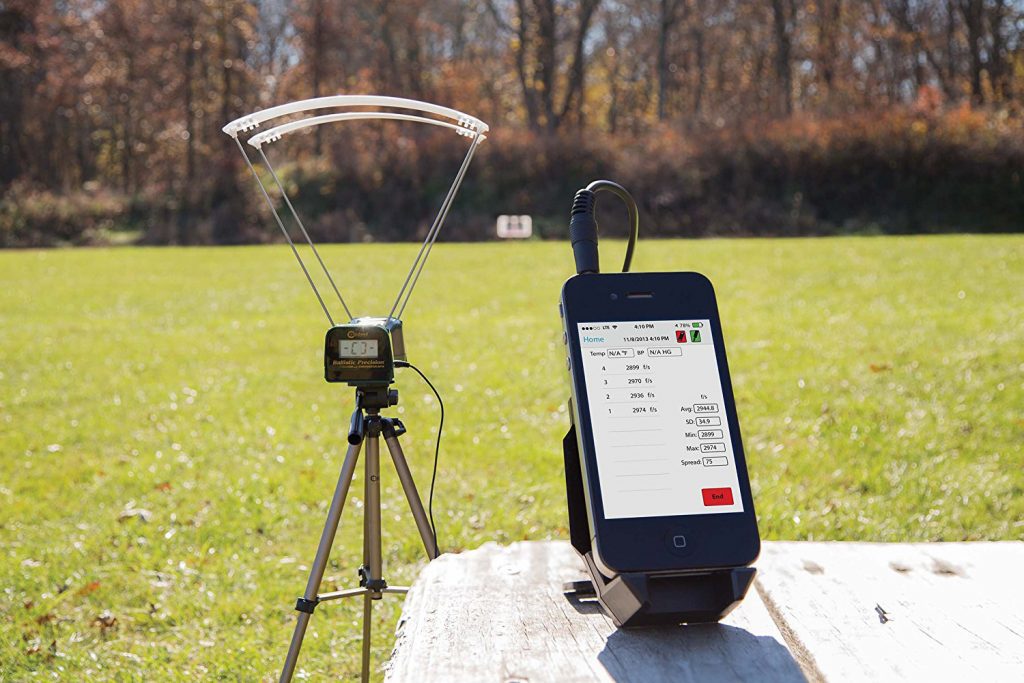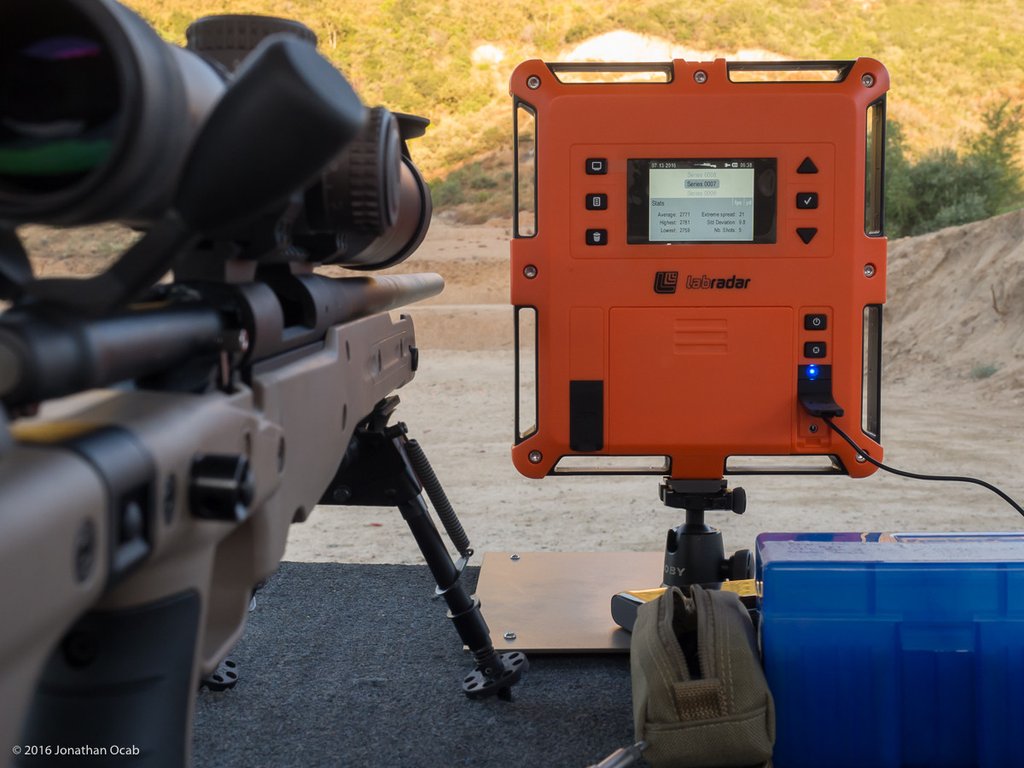
Ballistic chronographs are excellent tools that can bring a whole new dimension to your reloading efforts. There is much more to developing a highly accurate load for a particular rifle and bullet combination than simply preparing some samples and heading to the range for test firing.
Understanding how the different bullets react to different powers and different powder loads can increase your accuracy, especially at longer distances.
Yes, using a ballistic chronograph correctly can be a challenge. There is math involved in using the results. It would help if you also exercised some good habits when using your ballistic chronograph to get the best results and most accurate data.
Making the best use of your chronograph demands an understanding of how your ballistic chronograph works.
What is a Ballistic Chronograph?

At its simplest, a ballistic chronograph is a measuring instrument. These devices use various methods to detect and measure a bullet’s velocity as it passes through the ballistic chronograph’s sensing devices.
Most of the ballistic chronographs used by modern shooting enthusiasts use optical sensors to detect the bullet’s passage over the ballistic chronograph. Since the distance between the sensors is a known value, the computer inside the chronograph can compute the bullet’s speed as it passes.
In case you’re looking for the best shooting chronographs to develop the perfect load, I have covered about it on one my the popular articles: The Best Shooting Chronographs: Time to Optimize Reloading!
Making the Most of Your Chronograph
Making the most of your ballistic chronograph means getting the best and most consistent data possible. Some key factors affect the reliability of the data your ballistic chronograph can provide.
Failing to collect consistent data leads to errors in your assumptions and eventually results in less than optimal loads for your rifle or handgun.
Repeatability is the key to consistency. Repeating your ballistic chronograph setup, shooting in the same way, at the same spot, and under the same conditions will return consistent results.
Let’s begin looking at the common parts of ballistic chronographs and then some tips to getting the most consistent data results.
The Parts of Your Chronograph

Ballistic chronographs, for the most part, are surprisingly simple gadgets. Most ballistic chronographs used by shooters consist of a long housing that contains the electronics and the sensors, four rods or wires, and some sort of diffuser that fits on top of the rods.
The housing has openings at each end through which the optical sensors point. The sensors, called skyscreens, see the bullet as it passes between the rods and under the diffuser.
The electronics inside the ballistic chronograph housing then calculate the speed of the bullet and display the information.
Newer ballistic chronographs will connect to a smartphone app that allows you to view the data in real-time without having to go to the screen on the chronograph after each shot.
These apps usually include a memory function to save all the data from your test shots and other functions to calculate standard deviation, average velocities, etc.
The Keys to Consistent Data
As I have mentioned getting consistent data from your ballistic chronograph is a matter of being consistent with your setup and use. Many factors can affect how well your ballistic chronograph works. Understanding these factors is a large part of consistency.
Light
Your ballistic chronograph must see the bullet as it passes the skyscreens to calculate the velocity accurately. The best lighting conditions for your ballistic chronograph is an overcast day.
The diffused light makes the sensor’s job much easier. The worst lighting condition is having your chronograph in direct sunlight.
On overcast days or if you can put your ballistic chronograph in the shade, remove the diffusers from the rods. In direct sunlight, leave the diffusers in place. Some shooters use sun shields on their ballistic chronographs to provide optimal light conditions. S
ome ballistic chronograph manufacturers offer light diffusers and shade devices as accessories for their ballistic chronographs.
You should avoid using your ballistic chronograph near sunrise or sunset. The low angle of the light can confuse the sensors and give false or unreliable readings.
Cleanliness
Keep the clear covers over the skyscreen sensors clean. Dust tends to settle and stick to these covers. Too much dust can interfere with the sensor’s ability to see the bullet as it whizzes past.
Be careful not to scratch the clear covers on the skyscreens. Scratches can cause reflections that may well cause your ballistic chronograph to fail to operate effectively.
Keep Things on the Level
Your ballistic chronograph must sit level and be both parallel and perpendicular to the bullet’s flight through the skyscreens. The calculations that give your bullet’s velocity readings are dependent on a fixed length of travel between the sensors.
If the chronograph is not perfectly level, the bullet will travel a slightly longer distance as it passes over the sensors. This extra distance can skew your data enough to make a big difference.
If your ballistic chronograph is unlevel, instead of twelve inches between the skyscreens, the bullet may travel 12.5 inches. This extra half an inch can make a tremendous difference in the velocity readings from the chronograph.
This difference can be as much as a 120 feet per second error in the bullet’s velocity in some cases.
Set the Chronograph as the Same Distance Each Time
It should make sense to place your ballistic chronograph at the same distance from the muzzle of your gun each time. Setting up at the same distance ensures that the calculations are based on the same settings, yielding more consistent results.
Ideally, the ballistic chronograph should be no more than 20 feet from the muzzle and no closer than 10 feet to the muzzle of your firearm.
Be Aware of Your Bullets Path
Most rifles with a scope place the bullet’s path two to three inches below the scope’s actual line of sight. Keep this in mind as you set up your rifle and your ballistic chronograph. Sight your rifle to send the bullet near the center of the skyscreen area as possible and directly over the sensors’ center.
The most embarrassing moment you can have at the range is when you accidentally forget to allow for the height of your scope over the rifle barrel’s bore and shoot your ballistic chronograph.
Understanding the Data From your Ballistic Chronograph
Now that you are back from the range and have a mass of data about your new loads, how do you interpret that data to your best advantage? Getting consistent data from your ballistic chronograph is really the easy part.
Figuring out what the data is telling you can be much more difficult.
What to Look for in Ballistic Chronograph Data?
The data from your ballistic chronograph can tell you much more than how fast your bullets were traveling as they leave the barrel of your gun. For instance, you can interpret the data to learn such things as:
- How well your rifle and your loads perform with a cold barrel or a hot barrel
- How many shots it takes for enough fouling to build up to affect the accuracy of your shots
- The average overall velocity of your loads
- You can calculate the average velocity per grain of powder in each load
- You can see in the data the deviation between shots of the same load
It is that last bit of information that interests most shooters. The standard deviation in your loads tells you how accurate you can expect the load to perform.
The higher the standard deviation, the less consistent the accuracy of your loads.
What is Standard Deviation?
Standard deviation is a measure of the uniformity of the performance of your loads. The higher the standard deviation, the more inconsistent the performance of your loads will be. The standard deviation is essential when striving for repeated accuracy.
Even minor differences in your bullet’s velocity will cause significant differences in the point of impact at longer ranges.
How do I Calculate Standard Deviation?
Well, there is a formula. However, unless you are a mathematician or a statistician, it may not make much sense. The mathematical formula for standard deviation looks like this:

That is a little overwhelming unless you are well versed in higher math. In simple terms, this formula calculates the variance between each of the shots. The formula translates these differences into a single number that defines how significant those differences are in relationship to each other.
Don’t despair. Most modern ballistic chronographs will calculate the standard deviation from your data automatically.
You needn’t dust off your TI calculator or your old slide rule to get the data you need.
Using Standard Deviation to Interpret the Data
Let’s say you shot five rounds with a new load for your file. After you calculate the standard deviation, you find the loads show a standard deviation of 25.
You could reasonably interpret that data indicating that one-fourth of the rounds you load will fall outside the expected velocity. This deviation can be either faster or slower than what you expect.
In either case, the velocity difference would make a difference in the bullet impact point downrange. The ideal is a very low standard deviation. My example is an extremely high standard deviation to make the point easier to understand.
Do I have to do the Math?
Fortunately, most of the ballistic apps that come with modern ballistic chronographs can calculate your standard deviation automatically. If you use an older chronograph that doesn’t have this convenience, a quick search of the internet will return many calculators that will give you the standard deviation from a set of data quickly and easily.
In the end, it’s All About How You Use the Data
Your goal may be more consistent accuracy for competitive target shooting or a degree of confidence in your custom loads when hunting at long ranges. In either case, using the data from your ballistic chronograph can aid in the development of consistent loads that deliver the kind of results you seek.
Learning how to interpret the data from your ballistic chronograph is the key to developing your loads.
Over and Out!
Image Sources:
